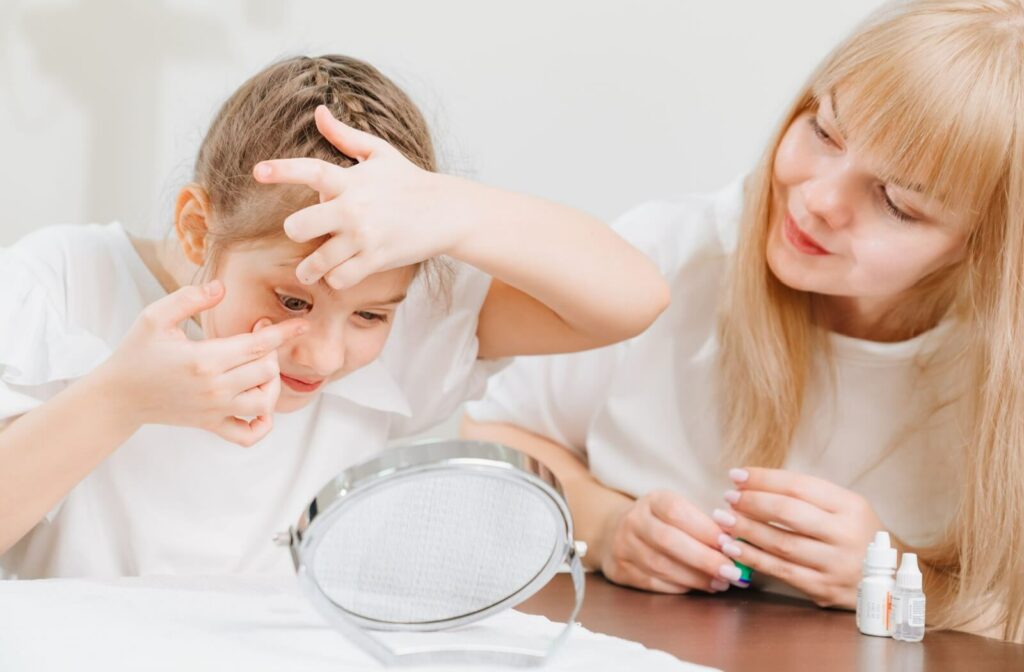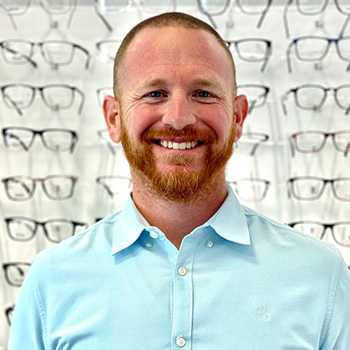If you’ve noticed your child’s prescription for glasses or contact lenses changing more often as they grow, you’re not alone. For many children and teens, myopia—or nearsightedness—typically progresses rapidly during their adolescent years.
Fortunately, myopia progression tends to go down after puberty as growth begins to slow down. But whether or not myopia progression slows with age does not mean you shouldn’t work with your child’s eye doctor on myopia control solutions.
If myopia is left to progress, it can turn into high myopia, which can continue progressing and increase the risk of other eye complications later in life. So, if your child is experiencing any myopia symptoms, it’s essential to visit the eye doctor for a comprehensive eye examination.
What Is Myopia & How Does It Progress?
Myopia is a common refractive error that causes distant objects to appear blurry while nearby objects remain clear. It occurs when the eyeball grows too long, preventing light from focusing directly on the retina. This growth process typically accelerates during childhood and adolescence, making glasses or contacts necessary as prescriptions change.
But what drives this progression? The answer lies in the eye’s structural growth. Just as the rest of the body grows during childhood and puberty, so does the eye. The eyeball continues to elongate for children with myopia, worsening the error over time.
This is why timely intervention is crucial. Catching these changes early can slow their progression and reduce the risk of developing high myopia, a severe form of myopia that may lead to complications like glaucoma, retinal detachment, or macular degeneration later in life.
The Link Between Puberty & Myopia Progression
So, does myopia progression stop—or at least slow down—when puberty ends? In many cases, the answer is yes. Myopia progression tends to stabilize once your child enters their late teens or early twenties.
This stabilization is likely because the eye has completed most of its growth. Just as height stops increasing after puberty, the eyeball elongation also slows, reducing the rate at which prescriptions change.
But while the end of puberty marks the natural slowing of myopia progression for many, it’s not a universal truth. Environmental factors, lifestyle habits, and even genetics can affect whether myopia stabilizes or continues to progress into adulthood.
Myopia Control Methods
Slowing myopia progression is possible through a variety of scientifically backed myopia control methods. While these techniques are typically most effective during childhood and adolescence, they can still play a vital role beyond puberty.
Here’s an overview of some of the most common myopia control methods.
Atropine Eye Drops
Atropine is a low-dose medication applied as eye drops, known for its effectiveness in slowing eyeball elongation. Typically administered daily, atropine has shown significant success in reducing myopia progression during childhood.

Orthokeratology (Ortho-K)
Ortho-k involves wearing special rigid contact lenses overnight to reshape the cornea temporarily. This reshaping corrects vision and can help slow myopia progression. After a night’s wear, your child can see clearly during the day without glasses or contacts.
Multifocal Contact Lenses
Regular soft contact lenses can correct myopia for clear vision, but they do nothing to stop its progression. However, special soft multifocal contact lenses designed with multiple zones that simultaneously focus light differently can reduce the stimulus for excessive eyeball growth. These are often an excellent option for older kids and teens.
Glasses with Myopia Control Lenses
Special eyeglasses, such as those with defocus-incorporated multiple segments (DIMS) or multifocal lenses, are designed to manage myopia progression while offering appropriate vision correction.
While these interventions are effective, it is essential to consult an eye care professional to determine the best approach for individual cases.
Lifestyle Adjustments & Their Impact
While medical interventions are key, lifestyle habits can influence myopia progression.
Increase Outdoor Time
Research shows that spending two or more hours outside daily reduces the risk of myopia progression. Natural light may help regulate the eyeball’s growth and overall eye health. Encourage outdoor play and activities—bonus points for leaving screens behind.
Limit Screen Time
Prolonged use of digital devices can strain the eyes and potentially accelerate myopia progression. Practice the “20-20-20″ rule—look at something 20 feet away for 20 seconds every 20 minutes—and encourage screen breaks throughout the day.
Optimized Workspaces
Children and teens often adopt poor posture when studying or working on laptops. For activities requiring near work, ensure proper lighting and an ergonomically sound setup.
Maintain a Balanced Diet
A diet rich in vitamins A, C, and E and omega-3 fatty acids supports eye health. Load up on foods like carrots, spinach, salmon, and nuts to provide the nutrients eyes need to thrive.
Managing Myopia Beyond Puberty
While myopia might stabilize for many as puberty ends, it’s not guaranteed for everyone. Adopting a proactive approach to monitoring eye health and leveraging scientifically backed interventions is key to managing myopia at any age.
Eye health is a lifelong commitment, and with advancements in myopia control methods and healthier lifestyle practices, it’s easier to protect your vision long-term. Whether you’re a parent supporting your child through this process or someone experiencing myopia yourself, knowledge is power.
Call our team at Dr. Bittel Optometry to book an appointment for you or your child if you’re experiencing any signs of myopia. After a thorough eye examination, one of our eye doctors can offer tailored advice.


